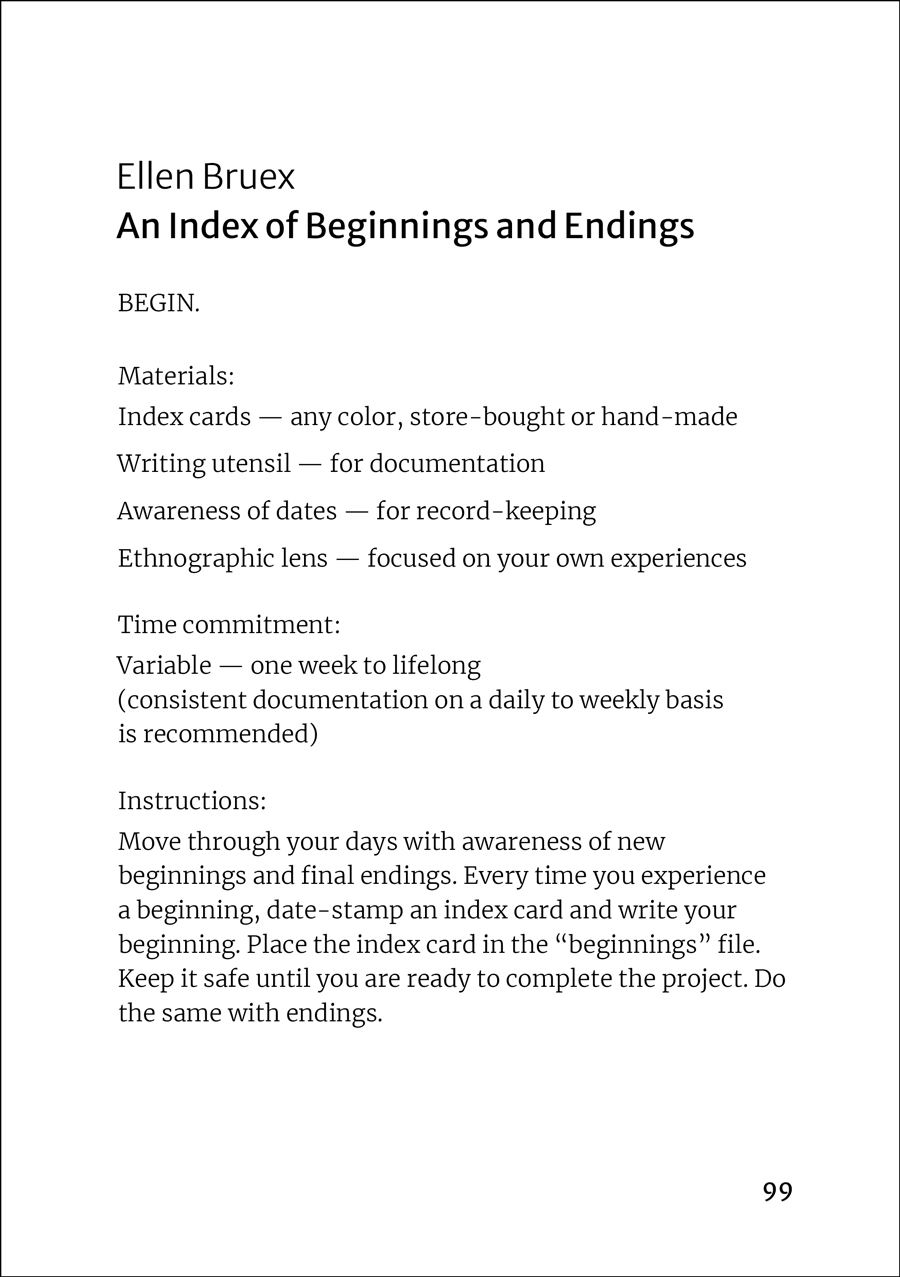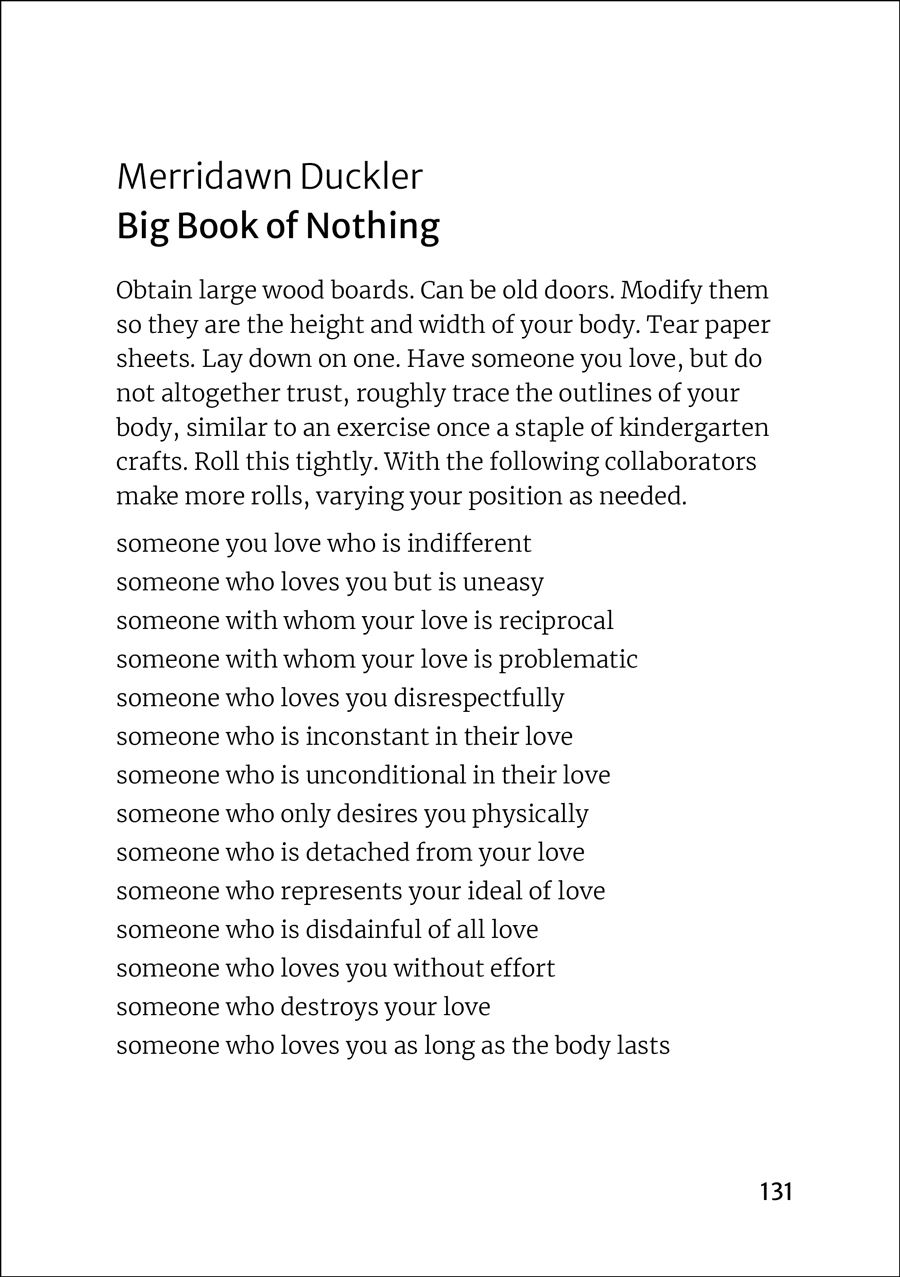In 2022 we edited and published an anthology of conceptual artist books titled A Physical Book Which Compiles Conceptual Books by Various Artists. The books in the collection exist only as verbal descriptions, statements, or provocations. However, we found the Conceptual label too narrow for many of the books. Through the project, we learned the many ways and reasons that an artist book might go unrealized. The purpose of this blog post is to share some of those ways and reasons, and to consider what they tell us about the field of artist books.
Faced with the challenge of categorizing the wildly diverse artist books we received, we organized our anthology according to Francis Bacon’s lofty system of human knowledge: Memory, Reason, Imagination. Recognizing such a system’s limitations, we added a fourth category: Touch. Any number of other organizational systems would have been possible (and many of the works fit just as un/comfortably into more than one category). Accordingly, this post will categorize books in yet another way, one that accounts for immaterialities beyond Conceptual art: conceptual, unrealized, implausible, impossible, and ekphrastic. From these, we can begin to learn what books can and can’t do, why books seem suited to certain topics, and what artists need for a sustainable practice.
Conceptual
When Levi first envisioned the anthology, he pictured conceptual books in the vein of 1960s and ‘70s Conceptual art, and we did receive such books. Like many Fluxus publications, these conceptual books build a frame through which to view everyday experiences in a new light. An Index of Beginnings and Endings by Ellen Bruex makes this explicit: “Instructions: Move through your days with awareness of new beginnings and final endings.” Some instruction pieces lend themselves to execution, relying on chance to produce novel outcomes. Random Color Generated Instant Book by Esther K Smith & Susan Happersett exemplifies this approach with detailed, plainspoken instructions and everyday materials. Other instructions are more poignant as mental exercises. In this category, we would place Who Has Seen the Wind by Cathryn Miller of Byopia Press. One could feasibly print her ninety-nine sonograms of the wind, but it is Miller’s Duchampian declaration that these imagined prints are art, specifically asemic poems, that is so striking. Despite their variety, these works all share Conceptual art’s emphasis on the viewer/reader rather than the artist. They remind us that reading is a creative, constitutive act.

Ellen Bruex, “An Index of Beginnings and Endings,” page 1 of 2, in A Physical Book Which Compiles Conceptual Books by Various Artists, eds. Carley Gomez and Levi Sherman, 2022.
Unrealized
Whereas Smith and Happersett’s conceptual book can be realized repeatedly according to chance operations, other books describe a more determined form. Perhaps the clearest example is Bruno Neiva’s Open your book!, which is bound on both sides and meant to be torn apart to relieve stress. A physical version of Open your book! was published by Team Trident Press a month after our anthology.
Other books say more by remaining unrealized. In Coma (deep sleep), Amandine Nabarra grapples with the difficulty of grieving her stepmother without saying goodbye due to COVID-19. Her frank description of guilt and pain alongside that of an unfinished collage is surely as poignant as the finished piece would have been. Linda Parr’s Circumnavigation outlines a book-in-progress meant for an exhibition celebrating Magellan’s quincentennial in 2020. The pressure to make art during an unprecedented pandemic seems perfectly captured by Parr’s reflections on Magellan, whose 1520 departure is celebrated but not his 1521 death or the 1522 return of his expedition under Juan Sebastián Elcano. Other unrealized books require elaborate installations or resources beyond most book artists, and still others — like Kristen Lyle’s Just a Phase — describe perfectly feasible projects where life has simply gotten in the way.

Amandine Nabarra, “Coma (deep sleep)” in A Physical Book.
Implausible
Without negating the real circumstances that result in unrealized books, whether structural or personal, we consider implausible books a separate category. These books are technically possible, but they place significance on mental processes — the reader’s imagination and the artist’s hypothetical thinking and mental problem solving. Nervous System by Andrew David King entails: a hidden bunker, a burlap sack of dirt, a single chair, a redacted facsimile of Edgar Kupfer-Koberwitz’s Dachau diaries, a cassette tape and player, and an iron supplement in a paper envelope. King’s piece is far more affecting than it seems from the description above, and perhaps the physical installation would be even more moving, but Nervous System seems written in lieu of that version, not as a practical plan. Not only is Nervous System more accessible in its verbal form, King has pruned and polished the writing as carefully as any poem. Contributions by James Spyker range in plausibility, from Clean After Reading, in which printed glycerin sheets are pressed into soap bars and then read as they are used, to Read it or else, which envisions a book as “voluntary ransomware” that must be painstakingly read to relinquish the reader’s computer. Implausible books make use of the book as a physical, time-based medium as well as its symbolic value.

James Spyker, “Clean After Reading” in A Physical Book.
Impossible
Impossible books also engage the book as a medium, but do so by pointing to its material and temporal limits. Nathanael Kooperkamp desires a sort of time travel in Future Memory Photo Album. Kyla Anne Spencer’s An accordion book (never ending) explicitly invokes infinity as does, effectively, VON WEIT HER(GEHOLT)’s imagined bestiary Life, Life-Size: Complete Collection. Numerous books connect the duration of books and lives. In Everything I never told you, Abigail Guidry imagines adding a signature to a codex on every birthday. Annelyse Gelman’s Tamagotchi-like PET requires care to remain readable. Even as such thought experiments challenge the limits of books, they also metaphorize the ways ordinary books and reading already transcend these limits. Narges Porandekhial’s Nothing and Everything and Nanette Wylde’s soul haiku both explore notion that no reader can encounter the same book twice.

Nanette Wylde, “soul haiku” in A Physical Book.
Other impossible books are plausible books in impossible worlds. Genocide Incorporated by E.L. Gamble and The Book of Davron by ossa are both set in dystopian, sci-fi futures. Another form of speculation accounts for other impossible books, books which cannot even be described. Constanze Kreiser’s A Book on Jellyfish asks how a book might adequately capture the animal’s essence — not unlike Sydney Anne Smith’s make a book like a dog.
Ekphrastic
Ekphrastic books are a literary device to explore other subjects. Almost pataphorical, these books are fleshed just enough for the writer to move beyond them. In Ben the Hoose, Bea Drysdale makes a pamphlet while staying at her parents’ house, plumbing her grief and fear while her ailing father is quarantined in the hospital. In Maureen Alsop’s haunting prose poem Tally Ho Écriture Féminine Mechanique, the book is “the ash and the remaining cigar boxes,” “an interrupted line of thought.” Merridawn Duckler also explores relationships in Big Book of Nothing, which begins like a Conceptual instruction book, but in a long litany asks the reader to consider “someone you love who is indifferent, someone who loves you but is uneasy, someone with whom your love is reciprocal…” and so on. At first, the book seems absent altogether in Lily Oliver’s Appendage, though a footnote mentions reading. Conspicuously absent, the book has a way of claiming other objects, spaces, and stories — perhaps the crawl space is a book, and the camera with a single photo is almost certainly a book.

Merridawn Duckler, “Big Book of Nothing,” page 1 of 2, in A Physical Book.
Thinking Books
In 2015 Levi contributed a post to this blog titled “Book Thinking,” arguing that artist books offer critical and analytical tools for other disciplines. The artists above illustrate the potential of book thinking by thinking books. If book thinking is critical or analytical, thinking books is its creative counterpart. Just as these artists think books into existence, the reader can think them into new categories and make new discoveries about artist books as a medium and as a discipline.
Carley Gomez is an artist and writer in Madison, Wisconsin. Levi Sherman is a PhD student in Art History at the University of Wisconsin—Madison and the founder of Artists’ Book Reviews. Together they run Partial Press, publisher of A Physical Book Which Compiles Conceptual Books by Various Artists.

